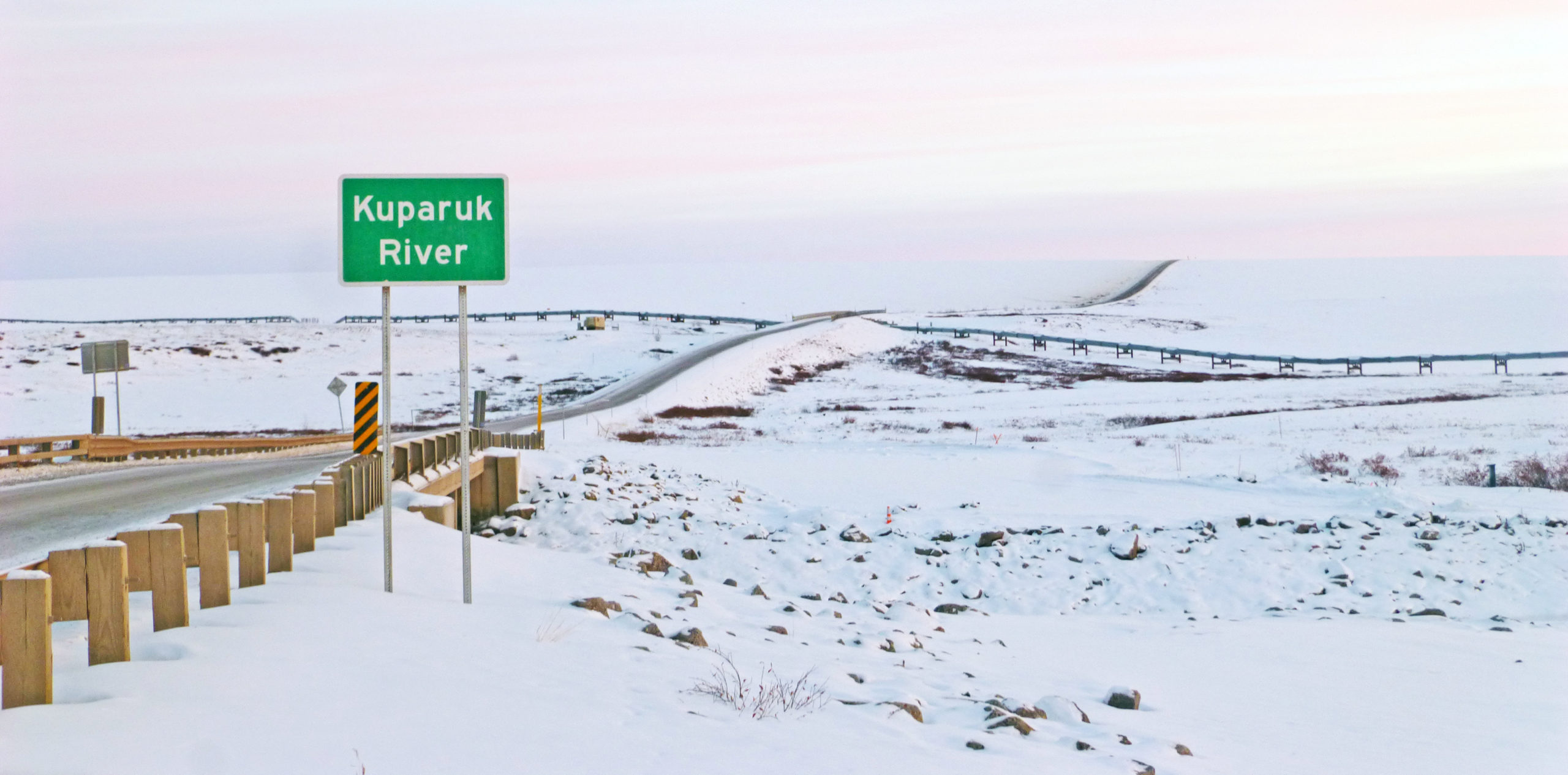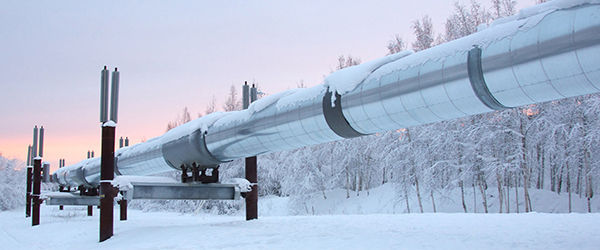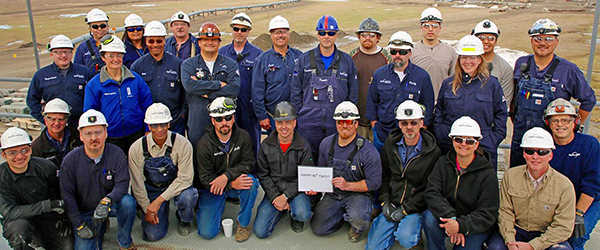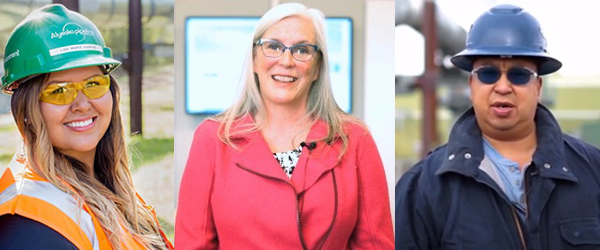TAPS construction
“They didn’t know it couldn’t be done.”
This was the motto adopted by Alyeska’s first employees – tens of thousands of men and women who teamed up to tackle the world’s largest privately funded construction project. And that now famous (and infamous) quote is now set in concrete on a statue in Valdez, celebrating the workers who built the iconic pipeline.
Designing and building the Trans Alaska Pipeline System presented unprecedented challenges. The 800-mile-long steel pipe would cross mountain ranges, rivers and major earthquake fault lines. Alaska’s semi-frozen permafrost prompted the engineering decision to build more than half the line above ground. Teams lived in construction camps along the line. The largest field camp at Isabel Pass had more than 1,600 beds. The smallest, Sourdough, could hold 125 workers. In all, more than 70,000 individuals worked on TAPS’ construction.
Considering the project’s scope and Alaska’s harsh conditions, crews worked at an astonishing pace: Construction on roads, facilities and the pipeline began in April 1974 and finished in June 1977. Oil flowed on June 20, 1977, and the first tanker carrying Alaska North Slope crude oil pulled away from its berth at the Valdez Marine Terminal on August 1, 1977. The final price tag on TAPS’ construction: a staggering $8 billion.
The final numbers
Time: Three years, two months (April 29, 1974 to June 20, 1977) to complete pipeline, pump stations, roads and Terminal.
See TAPS Construction Timeline below
Cost: Approximately $8 billion for entire system, including Valdez Marine Terminal and pump stations, at conclusion of initial construction period in 1977. Does not include interest on capital investment or capital construction after 1977.
Contractors and Subcontractors: 2,000, approximately.
Workforce:
- Minority hire: Ranged from 14-19 percent.
- Peak, contractors only: 21,600.
- Peak, total: 28,072 in October 1975 (Alyeska employees and contractors).
- Total for project: 70,000 approximately (1969-1977).
- Women: Ranged from 5-10 percent.
Fatalities: 32 incidents directly related to construction (includes employees of Alyeska, contractors and subcontractors; excludes common carriers).
Camps: Largest camp: Valdez Marine Terminal, 3,480 beds.
- Largest pipeline camp: Isabel Pass, 1,652 beds.
- Number, from 1974-1977: 29 total.
- Smallest pipeline camp: Sourdough, 112 beds.
Pump Stations: Original design called for 12 pump stations with four pumps operating at each pump station. PS 11 was never built.
Learn more about the TAPS Pump Stations
Valdez Marine Terminal (Terminal): The Terminal was designed to load tankers and provide the storage capacity in TAPS to allow production on the North Slope to operate without impact-related delays from the marine transportation system. It occupies approximately 1,000 acres on the southern shore of Port Valdez. Cost to build: $1.4 billion.
Early history
Early history: The Trans Alaska Pipeline System (TAPS) was originally called the Trans Alaska Pipeline Project, and was a joint venture of Atlantic Pipe Line Company (now ConocoPhillips Transportation Alaska, Inc.), Humble Oil Pipeline Company (now ExxonMobil Pipeline Company) and BP Oil Corporation [later BP Pipelines (Alaska) Inc.], formed to develop a plan for construction of a pipeline for Prudhoe Bay oil.
Time for pre-construction effort: Six years, approximately.
Learn more at Countdown to Construction
Notices to proceed: 465 federal and 403 state notices to proceed were required from the Federal Alaska Pipeline Office and the State Pipeline Coordinator’s Office.
Permits: 515 federal and 832 state permits were required to build TAPS.
Archeological survey, pre-construction: The entire TAPS route was surveyed by the University of Alaska and Alaska Methodist University under contract to Alyeska. The survey, which cost approximately $2.2 million, resulted in the excavation of approximately 330 sites.
Soil surveys, pre-construction:
- Bore holes: 3,500, approximately.
- Soil samples: 15,000, approximately.
Materials
- Gravel for entire project: 73 million cubic yards.
- Gravel for work pad: 32 million cubic yards.
- Largest piece shipped: Floating tanker berth (3,250 tons).
- Shipped to Alaska: 3 million tons, approximately.
Pipe: Pieces required for pipeline: More than 100,000 – 40- and 60-feet long, 48 inches in diameter.
Total pipe shipped: 550,000 tons, approximately; 120 shiploads for original construction. Manufactured in Japan.
Pipe welds
- Double joints: 42,000 (a double joint is two pipe sections welded into a single length before transport to the field for placement in the line).
- Field girth welds: 66,000.
- Passes for field girth welds: Seven for 0.562- inch pipe; six for 0.462-inch pipe.

More milestones
Dalton Highway (Formerly North Slope Haul Road): Constructed by Alyeska in the winter of 1969-70. Originally owned by Alyeska; control transferred to the State of Alaska in October 1978.
Haul Road (Portion of Dalton Highway from the Yukon River to Prudhoe Bay.) Built by Alyeska, started April 29, 1974; completed and dedicated September 29, 1974.
Learn more about the Dalton Highway and Haul Road
Bridges:
Pipeline: 13 total along TAPS.
Road: 10 north of Yukon; 36 south of Yukon.
Yukon River bridge: Located at MP 353.3, construction dates: 1974-1975. Opening date: October 1979.
Learn more about Bridges on TAPS
Airfields:
- Seven, 2,500 to 3,000 feet long.
- Seven, 5,000 feet long.
Operations: Two of the 14 airfields built during TAPS construction are still in operation: Galbraith Lake (5,200 feet long) and Prospect (5,000 feet long). These two airfields are on federal land and are operated under state leases.
Ditch:
Buried Pipeline: 8 feet wide, 8 feet deep, approximately, but variable for overburden depth, which ranged from 3 to 35 feet.
Construction Timeline
See Countdown to Construction for the years of work and negotiations that took place before construction began
See Since Start-up for a timeline of 40-plus years of work on TAPS since oil entered the pipeline.
1974
April 29 Construction of road from Prudhoe Bay to Yukon River begins.
May 3 State right-of-way lease issued.
Sept. 29 Road from Prudhoe Bay to Yukon River completed.
1975
March 27 First pipe laid at Tonsina River.
Oct. 11 Yukon River Bridge completed.
Oct. 26 Pipeline project 50 percent complete.
1977
May 31 Final pipeline weld near PS 3.
June 20 First oil flows from PS 1
(10:26 a.m. Alaska Standard Time, pig in trap; 10:27 a.m. Alaska Standard, pig depart signal)



